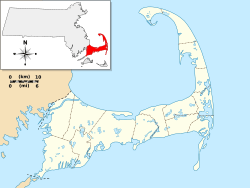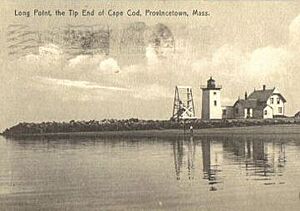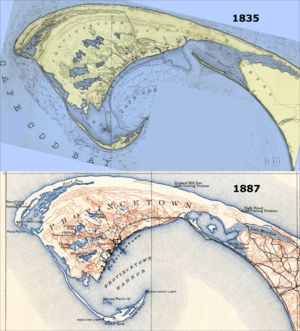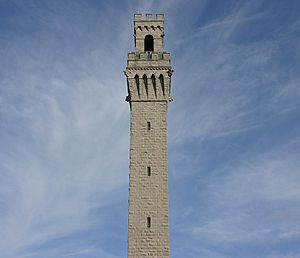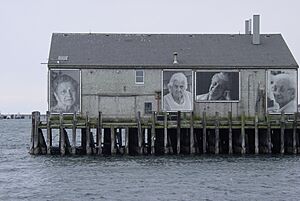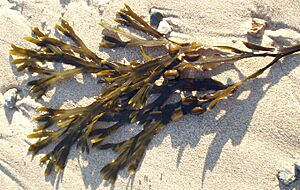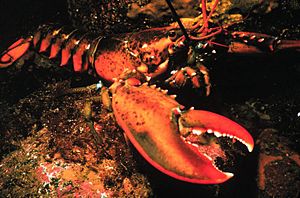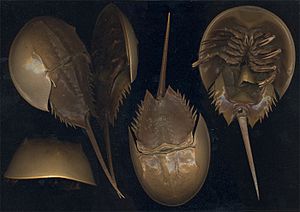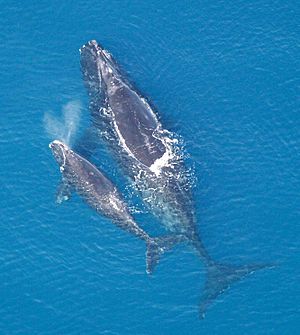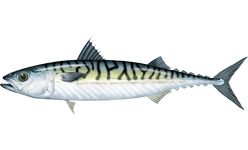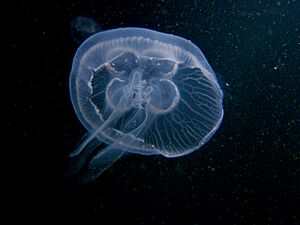Provincetown Harbor facts for kids
Quick facts for kids Provincetown Harbor |
|
|---|---|
 |
|
| Location | |
| Country | United States |
| Location | Provincetown, Massachusetts |
Provincetown Harbor is a big, natural harbor in Provincetown, Massachusetts. It's a deep bay, usually about 30 to 90 feet (9 to 27 meters) deep. The harbor stretches about 1 mile (1.6 km) from northwest to southeast. It also goes about 2 miles (3.2 km) from northeast to southwest. This large, deep area means boats can easily enter and leave without needing a special channel dug for them.
A tall green buoy marks the entrance to Provincetown Harbor. This buoy is east of Long Point, which is the very tip of Cape Cod.
Contents
How Provincetown Harbor Was Formed
Most of Cape Cod was shaped by a giant ice sheet. This ice sheet, called the Laurentide Glacier, was here between 18,000 and 15,000 years ago. But the land around Provincetown Harbor is different. This area, called the Provincetown Spit, was formed later. It's made of sand and other materials. These materials were carried here by ocean currents over the last 6,000 years.
History of Provincetown Harbor
In 1805, a stone wall was found in Provincetown. Some people think Viking explorer Thorvald Eiriksson built it around the year 1007. Old Norse stories say that Ericson's ship was fixed in the harbor around that time.
Early Explorers Visit the Harbor
Bartholomew Gosnold explored the harbor in 1602. His shipmate, Gabriel Archer, wrote about finding a "large opening" and lots of cod fish. They called the area "Cape Cod" because of all the fish.
John Smith explored the harbor in 1614. He described Cape Cod as "high hills of sand" but also an "excellent harbor for all weathers." He said the cape looked like a "sickle."
Pilgrims' First Landing in 1620
Provincetown Harbor was the first place the Pilgrims landed in 1620. They were on their ship, the Mayflower. They stayed here before sailing on to Plymouth. A book from that time, Mourt's Relation, called the harbor "a good harbor and pleasant bay." It said 1,000 ships could safely stay there. The Pilgrims found wood, water, and many birds.
The Mayflower carried many different people, not just Pilgrims. On November 11, 1620, the Pilgrims and other settlers signed the Mayflower Compact in the harbor. This was an important agreement for their new colony.
Sadly, Dorothy Bradford, the first wife of William Bradford, drowned in the harbor on December 17, 1620. She fell overboard from the Mayflower. However, Peregrine White, the first child born to the Pilgrims in New England, was also born while they were in Provincetown Harbor.
Long Point Village
From 1818 to the 1850s, a fishing village was located at Long Point. It had a post office, a school, and 38 homes. About 200 adults and 60 children lived there. When the families left in the 1850s, they moved their homes. They floated them about a mile across the harbor. Many of these homes are still standing in Provincetown today.
During the American Civil War, soldiers built defenses at Long Point. These defenses were called "Fort Useless" and "Fort Ridiculous" by local people. Today, Long Point is a ghost village. Only the Long Point Light lighthouse remains.
East Harbor's Transformation
For a long time, the eastern part of Provincetown Harbor was connected to another harbor called East Harbor. East Harbor was a very safe place for boats. It had a wide opening, about 1,000 feet (300 meters) wide, to Provincetown Harbor.
Until the late 1800s, there was no good road into or out of Provincetown. The only way by land was a thin beach path. In 1868, a dike (a wall) was built across the mouth of East Harbor. This allowed for railroad tracks to be laid. A formal road was built in 1877. East Harbor then became a lake, connected only by a small pipe. In 1910, it was officially renamed Pilgrim Lake.
Over the years, the dike caused problems for the lake's wildlife. In 2004, the National Park Service helped restore the natural tidal flow to East Harbor. This brought back saltwater and helped marine life. In 2008, the lake was officially renamed East Harbor again.
Other Important Events
The Portland Gale storm in 1898 destroyed many wharves and fishing boats in the harbor.
In 2002, the US Environmental Protection Agency chose Provincetown Harbor Beach as a "Flagship beach." This means it's a model for other beaches in how it monitors water quality.
The harbor is also part of the Provincetown historic district. This district is listed on the National Register of Historic Places.
Landmarks and Piers
In the late 1800s, two main wharves were important: Railroad Wharf and Steamboat Wharf. Today, these have been replaced by piers. Even though trains and steamboats no longer come to Provincetown, ferry service still does.
MacMillan Pier is Provincetown's main pier. It was updated between 2003 and 2005. This pier is mostly used by tourists and high-speed ferries. These ferries take people to Boston and Plymouth. The pier is named after arctic explorer Donald Baxter MacMillan, who lived in Provincetown.
Next to MacMillan Pier is Fisherman's Wharf, also called Cabral's Pier. On this pier, you can see an art display called They Also Faced the Sea. It features five large portraits of local Portuguese-American women.
In 1907 and 1910, the entire U.S. Navy fleet visited the harbor. This was for ceremonies when the Pilgrim Monument was being built and when it was dedicated. Presidents Theodore Roosevelt and William Howard Taft led these events.
From the harbor, you can see three working lighthouses: Long Point Light, Wood End Light, and Highland Light. All three are part of the Cape Cod National Seashore.
On the East End of Provincetown, Lewis Wharf was bought by Mary Heaton Vorse. An old fish shack there became a theater. This theater was home to the Provincetown Players. Famous playwright Eugene O'Neill had his first play, Bound East for Cardiff, performed there in 1916.
Captain Jack's Wharf is on the West End. At another theater on that wharf, Tennessee Williams' play A Streetcar Named Desire was first performed. Marlon Brando played Stanley Kowalski in this early show.
The U.S. Coast Guard has buildings and barracks at the base of a concrete pier in the harbor. This station opened in 1979. It helps with safety and law enforcement in a large area of Cape Cod Bay and the Atlantic Ocean. This station was the first federal building to use solar power. You often see the station's 47-foot Motor Lifeboat in the harbor.
The West End Breakwater was built in 1911. It's open for people to walk and explore. It's more like a dike than a breakwater. The harbor also has a "true" breakwater built between 1970 and 1972. It's about 835 feet (255 meters) from the end of MacMillan Pier.
Marine Life in the Harbor
Provincetown Harbor is home to many different kinds of marine life. This includes tiny algae and plankton, as well as larger animals. You can find seagrasses, crabs, clams, fish, birds, and even marine mammals like whales.
The harbor is a very rich and busy place for nature. The tables below list many examples of marine life often seen in the harbor. Some land birds that are common around MacMillan Pier and on the beaches are also included.
| Seaweeds |
|---|
| Ulva (sea lettuce) |
| Irish moss (Chondrus crispus) |
| Pylaiella (mung) |
| bladder wrack |
| knotted wrack |
| codium fragile (dead man's fingers) |
| Crustaceans, Chelicerates, Molluscs | Other Invertebrates |
|---|---|
| American lobster | orange-footed sea cucumber |
| rock crab | Forbes' sea star |
| jonah crab | Atlantic purple sea urchin |
| portly spider crab | ctenophore (comb jelly) |
| calico crab (lady crab) | moon jelly |
| green crab | various sea sponges |
| Japanese shore crab | clam worm |
| long-clawed hermit crab | northern red anemone |
| flat-clawed hermit crab | stalked sea squirt |
| copepod | sea grape |
| gammarid amphipod (sideswimmer) | Didemnum sp. |
| isopod | chain tunicates |
| barnacle | golden star tunicates |
| skeleton shrimp | lacy crusted bryozoa |
| Atlantic horseshoe crab | tubeworm |
| longfin inshore squid | brittle-star |
| common slipper shell | salp |
| quahog (hard clam) | spiral tufted bryozoa |
| soft-shell clam (steamer) | snail fur |
| Atlantic bay scallop | tubularian hydroids |
| Eastern oyster (American oyster) | sinistral spiral tubeworm |
| common periwinkle | featherduster worm |
| northern moon snail | ice cream cone worm |
| oyster drill | |
| Eastern mudsnail | |
| blue mussel |
Historic Annual Events
The Great Provincetown Schooner Regatta happens every September. It celebrates the harbor's history as a big sailing port.
A Blessing of the Fleet ceremony is held in late June. All the boats in the harbor are blessed by a bishop. This is part of the Provincetown Portuguese Festival.
The Swim for Life takes place every September since 1988. People swim across the harbor to raise money and awareness for health causes.
Commercial Use of the Harbor
Today, many different boats use Provincetown Harbor. There are about a dozen fishing trawlers (called "draggers" by locals). Ferries go to Boston and Plymouth. Many sportfishing boats and boat rentals also operate here.
whale watching tours started from MacMillan Pier in 1975. These tours go to Stellwagen Bank National Marine Sanctuary. Other tour boat companies offer different trips. You can take historical tours, marine life tours, or sunset cruises.



